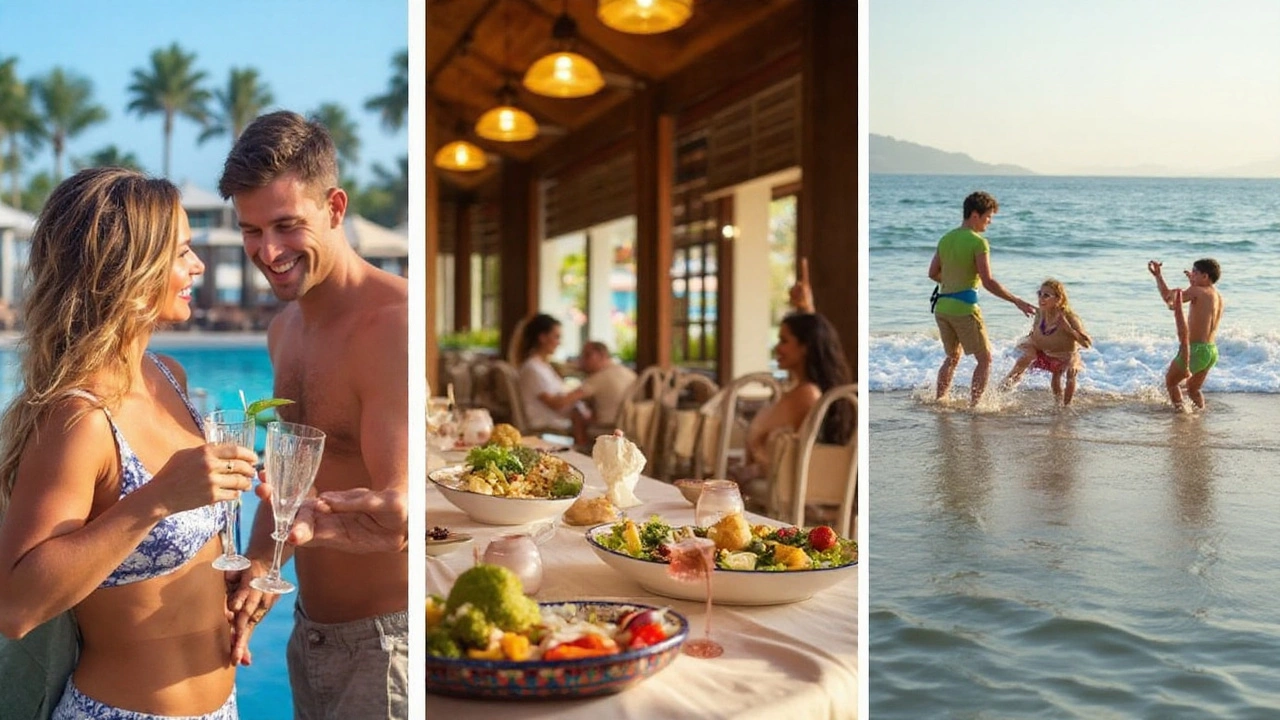You check into your hotel, hand over your luggage, and suddenly, you're off-duty. Poolside drinks? Yes. Buffet breakfast, lunch, dinner—and maybe even a midnight snack? Totally yours. The Wi-Fi password? Included. No calculating how much you spent at dinner, or arguing over the mini-bar. That's the vibe people dream about when they hear “all-inclusive”—but does it always work out like that?
What All-Inclusive Really Means
It sounds simple on paper: one price, everything covered. But spend five minutes scrolling through resort ads or reading the fine print, and you'll see there’s a world of difference between “all” and “almost all.” At some hotels, “all-inclusive” means every meal, soft drink, cocktail, poolside snack, and nightly show is part of the deal. At others, you might find yourself facing stealthy menus with footnotes that nudge you to upgrade your steak or say, “Sorry, that cabernet is extra.” So, what’s actually included?
- Meals and drinks, usually three full ones per day with snacks between.
- Local spirits, house wines, and often local beers—though imported labels may cost extra.
- Use of pools, gyms, and sometimes non-motorized water sports.
- Kids’ clubs, movie nights, and beach volleyball tournaments.
- Airport shuttles, gratuities, and Wi-Fi are sometimes bundled in.
The devil, as they say, lives in the details. I remember the first all-inclusive I visited with Fletcher. We were so excited for “free” mojitos every afternoon by the pool. But only the local rum was free; the good stuff cost more. It became a running joke—how many upgrades does it take to become exclusive in your own all-inclusive?
What’s Not Included: Surprises and Fine Print
Just when you think you’ve got a handle on everything covered, here come the surprises. Premium cuts of meat, candlelit dinners on the beach, full spa days, branded alcohol, and off-site excursions—these usually aren’t part of the package. If you don’t read the fine print, you’ll get sticker shock when you find out that paddleboard lesson or couples’ massage is an extra 60 bucks per head.
Resorts definitely want to upsell. If you’ve ever stayed somewhere that offered daily “complimentary” room upgrades, you know the drill. In fact, a 2023 survey from TripGlobal Insights (a real analytics company) found that more than 67% of all-inclusive guests spent an extra $160 to $200 each week on add-ons they didn’t expect.
Here are a few things to double-check before you pack your bags:
- Spa treatments and wellness classes—rarely included.
- Prenium or international drinks—often an upcharge.
- Off-resort activities, like guided hikes or scuba diving—these almost always cost extra.
- Kids’ special programs—some resorts charge per activity.
- High-speed Wi-Fi and business centers—sometimes pay-per-day.
- Room service outside certain hours—a secret fee trap.
Honestly, sometimes it feels like Jasper my cat’s reaction when promised tuna treats—seems like a lot, but then he sniffs the bowl and walks away unimpressed. Make sure you know exactly what you’re getting so you won’t be left pouting at a closed bar or an invoice loaded with “extras.”

Why Go All-Inclusive? The Real Benefits and Downsides
Why do people pick all-inclusive hotels in the first place? Let’s be real: most of us want predictability and zero stress. When you show up on vacation, it’s a relief to know you’ve already paid for the bulk of your experience—and you won’t get hit with surprise charges at checkout (unless you ignored the fine print).
Here’s where going all the way makes sense:
- You’re traveling as a family or group and don’t want arguments about splitting bills.
- You want to eat and drink what you want, when you want, without counting coins.
- You’re a planner at heart who likes things laid out, from mealtimes to entertainment.
- You want to focus on relaxing, not organizing daily logistics.
All-inclusives work beautifully for many types of travelers, but there are real downsides for some. If you love exploring street food, local restaurants, and off-the-beaten-track spots, you might feel hemmed in. City folk or adventure-seekers can get cabin fever, itching to see what’s beyond the resort walls. And if you don’t drink or you eat like a bird, the extra cost doesn’t always add up.
According to a 2024 report by Global Hotel Watch, 73% of respondents picked all-inclusive packages for convenience, but 45% said they spent at least one meal outside the resort anyway. It’s like paying for a streaming service and then renting a movie elsewhere.
| What’s Usually Included | What’s Often Not Included |
|---|---|
| Buffet meals | Premium dishes (steak, lobster) |
| House wine & drinks | Top-shelf/international alcohol |
| Snacks & poolside food | Specialty restaurants with a la carte menus |
| Use of pools, gyms, beach access | Spa treatments & massages |
| Nights shows, basic activities | Private tours & excursions |
| Airport transfers (sometimes) | Late-night room service (sometimes) |
How to Maximize Your All-Inclusive Stay
If you want to squeeze every ounce out of your all-inclusive package, strategy matters way more than you think. First: research, research, research. Don’t just rely on glossy marketing—dig through real reviews, and lookout for mention of annoying add-ons or anything “not actually included.”
- Check meal times and reservation policies for restaurants. Some places book up their a la carte spots days in advance. Jump on that early, so you don’t get stuck with the buffet every night.
- Don’t be shy—ask what exactly is included at check-in. Do it face-to-face rather than assuming the info on the website is up-to-date.
- Make friends with staff. A hotel bartender told me once that guests who learn the staff’s names (and tip a little extra, even if it’s already included) often get the quickest service and honest tips about resort perks.
- Mix up your routine. Alternate between active and lazy days to avoid feeling like you’re stuck in a loop of eating, drinking, and napping.
- Attend events and classes, even if they sound cheesy. I joined a salsa class on a dare and ended up having the most fun (thanks, Fletcher, for dragging me onto the dance floor). These extras can be memory-makers.
Also, don’t ignore local culture. Many resorts work with local artists or run off-site excursions—sometimes for a modest extra fee. It’s a chance to see more than the pool deck and souvenir shop.

Choosing the Right All-Inclusive: Not One-Size-Fits-All
When shopping for an all-inclusive hotel, start with your priorities. Traveling with a toddler? Look for a place with kids’ clubs, child-specific menus, and splash pads. Planning a couples’ retreat? Go for adults-only resorts with quieter beaches and candlelit dinners. Foodies? Hunt for resorts known for fresh ingredients, chef-led restaurants, or even partnerships with local farms.
Ask yourself how active—or lazy—you want to be. If you want structure, find resorts with daily schedules packed with activities, sports, and socials. If you just want to flop on the sand, look for ones with drink service on the beach and private cabanas. Accessibility matters too: some places are sprawling, and not every corner is wheelchair- or stroller-friendly.
Don’t just fixate on the nightly price. Sometimes the lowest price tags come with the most restrictions or hidden costs. Compare what’s truly included—meals, drinks, tips, minibar, Wi-Fi—and see how it stacks up against other options. Check if the resort feels safe and if it has trusted reviews about cleanliness. Oh, and see what the pet policy is, if you can’t travel without your Jasper. Some places are surprisingly pet-friendly, even for pampered cats.
Last tip? Trust yourself. Ask for clarity on what’s included, and don’t hesitate to insist on what you were promised. Travel is supposed to let your brain take a break for a while—don’t let squabbling over the bill ruin that perfect sunset moment.
